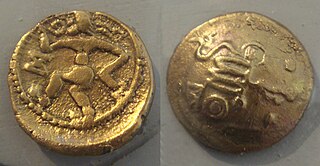Related Research Articles

The Lingones were a Gallic tribe of the Iron Age and Roman periods. They dwelled in the region surrounding the present-day city of Langres, between the provinces of Gallia Lugdunensis and Gallia Belgica.

The Aulerci Cenomani were a Gallic tribe dwelling in the modern Sarthe department during the Iron Age and the Roman period. The Cenomani were the most powerful of the Aulerci tribes.

The Petrocorii were a Gallic tribe dwelling in the present-day Périgord region, between the Dordogne and Vézère rivers, during the Iron Age and the Roman period.
The Medulli were a Gallic tribe dwelling in the upper valley of Maurienne, around present-day Modane (Savoie), during the Iron Age and Roman period.

The Santoni or Santones were a Gallic tribe dwelling in the later region of Saintonge during the Iron Age and the Roman period.

The Osismii, Ossismii, or Ostimii were a Gallic tribe dwelling in the western part of the Armorican Peninsula during the Iron Age and the Roman period.
The Lexovii, were a Gallic tribe dwelling immediately west of the mouth of the Seine, around present-day Lisieux, during the Iron Age and the Roman period.
The Seduni were a Gallic tribe dwelling in the upper Rhône valley, around present-day Sion, during the Iron Age and the Roman period.
The Veragrī were a Gallic tribe dwelling around present-day Martigny, in the Pennine Alps, during the Iron Age and the Roman period.
The Ceutrones were a Gallic tribe dwelling in the Tarantaise Valley, in modern Savoie, during the Iron Age and Roman period.
The Salassi or Salasses were a Gallic or Ligurian tribe dwelling in the upper valley of the Dora Baltea river, near present-day Aosta, during the Iron Age and the Roman period.

The Coriosolites or Curiosolitae were a Gallic people dwelling on the northern coast of present-day Brittany during the Iron Age and the Roman period.

The Redones or Riedones were a Gallic tribe dwelling in the eastern part of the Brittany peninsula during the Iron age and subsequent Roman conquest of Gaul. Their capital was at Condate, the site of modern day Rennes.

The Leucī were a Belgic tribe dwelling in the southern part of the modern Lorraine region during the Iron Age and the Roman period.

The Bituriges Vivisci were a Gallic tribe dwelling near modern-day Bordeaux during the Roman period. They had a homonym tribe, the Bituriges Cubi in the Berry region, which could indicate a common origin, although there is no direct of evidence of this.

The Gabali were a Gallic tribe dwelling in the later Gévaudan region during the Iron Age and the Roman period.

The Namnetes were a Gallic tribe dwelling near the modern city of Nantes during the Iron Age and the Roman period.
The Veliocasses or Velocasses were a Belgic or Gallic tribe of the La Tène and Roman periods, dwelling in the south of modern Seine-Maritime and in the north of Eure.

The Cadurci were a Gallic tribe dwelling in the later region of Quercy during the Iron Age and the Roman period.
The Uberi were a Celtic tribe dwelling near the source of the Rhône river, in the modern-day Canton of Valais (Switzerland), during the Iron Age and the Roman period.
References
- 1 2 3 Graßl 2006.
- ↑ Caesar. Commentarii de Bello Gallico, 3:1, 3:6, 4:10.
- 1 2 Pliny. Naturalis Historia, 3:20.
- ↑ Strabo. Geōgraphiká, 4:6:6.
- ↑ Tabula Peutingeriana , 2:3.
- ↑ Falileyev 2010, s.v. Nantuates.
- ↑ Kruta 2000, p. 71.
- 1 2 3 Wiblé 2007.
- ↑ Delamarre 2003, pp. 231–232.
- 1 2 Lafond 2006.
- ↑ Talbert 2000, Map 18: Augustonemetum-Vindonissa.
- ↑ Wiblé 2012.
Primary sources
- Caesar (1917). The Gallic War. Loeb Classical Library. Translated by Edwards, H. J. Harvard University Press. ISBN 978-0-674-99080-7.
- Pliny (1938). Natural History. Loeb Classical Library. Translated by Rackham, H. Harvard University Press. ISBN 978-0674993648.
- Strabo (1923). Geography. Loeb Classical Library. Translated by Jones, Horace L. Harvard University Press. ISBN 978-0674990562.
Bibliography
- Delamarre, Xavier (2003). Dictionnaire de la langue gauloise: Une approche linguistique du vieux-celtique continental. Errance. ISBN 9782877723695.
- Falileyev, Alexander (2010). Dictionary of Continental Celtic Place-names: A Celtic Companion to the Barrington Atlas of the Greek and Roman World. CMCS. ISBN 978-0955718236.
- Graßl, Herbert (2006). "Vallenses". Brill's New Pauly. doi:10.1163/1574-9347_bnp_e1228280.
- Kruta, Venceslas (2000). Les Celtes, histoire et dictionnaire : des origines à la romanisation et au christianisme. Robert Laffont. ISBN 2-221-05690-6.
- Lafond, Yves (2006). "Nantuatae". Brill's New Pauly. doi:10.1163/1574-9347_bnp_e816680.
- Talbert, Richard J. A. (2000). Barrington Atlas of the Greek and Roman World. Princeton University Press. ISBN 978-0691031699.
- Wiblé, François (2007). "Nantuates". Historical Dictionary of Switzerland . Retrieved 29 January 2022.
- Wiblé, François (2012). "Tarnaiae". Historical Dictionary of Switzerland . Retrieved 29 January 2022.
